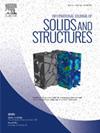Local formability and bendability of UHSS: Correlations between bending and tensile fracture strains
IF 3.4
3区 工程技术
Q1 MECHANICS
International Journal of Solids and Structures
Pub Date : 2025-06-14
DOI:10.1016/j.ijsolstr.2025.113524
引用次数: 0
Abstract
This study investigates the correlation between bendability and local formability properties of six ultra-high strength steel (UHSS) grades using small radius air-bending tests, uniaxial tensile tests, and plane-strain tensile tests with grooved specimens. Digital image correlation (DIC) was employed to measure surface strains, while post-mortem thickness measurements provided through-thickness strain data from the tensile tests. A novel strain-based method was used for bending fracture detection, offering improved accuracy over conventional methods such as the load drop thresholds defined in the VDA 238-100 specification. The bending fracture strain showed a moderate correlation (R2 = 0.73) with the plane-strain tensile fracture thickness strain. In contrast, correlations between bending fracture strain and uniaxial tensile fracture measures were weak (R2 = 0.38–0.53). No clear relationships were found between bending fracture strain and conventional tensile parameters such as total elongation or strain hardening exponent. The findings of this paper highlight the complexities in predicting bendability from tensile measures due to stress state differences and underscore the importance of bending tests for accurate characterization of sheet metal formability.

超高压钢的局部成形性和可弯曲性:弯曲和拉伸断裂应变的相关性
本研究通过小半径空气弯曲试验、单轴拉伸试验和带槽试样的平面应变拉伸试验,研究了六种超高强度钢(UHSS)牌号的弯曲性能和局部成形性能之间的相关性。数字图像相关(DIC)用于测量表面应变,而死后厚度测量提供了拉伸试验的全厚度应变数据。一种新的基于应变的方法被用于弯曲断裂检测,比传统的方法(如VDA 238-100规范中定义的载荷下降阈值)提供了更高的精度。弯曲断裂应变与平面应变、拉伸断裂厚度应变呈中等相关性(R2 = 0.73)。弯曲断裂应变与单轴拉伸断裂措施的相关性较弱(R2 = 0.38-0.53)。弯曲断裂应变与常规拉伸参数(如总伸长率或应变硬化指数)之间没有明确的关系。本文的研究结果强调了由于应力状态差异而从拉伸测量中预测可弯曲性的复杂性,并强调了弯曲试验对准确表征钣金成形性的重要性。
本文章由计算机程序翻译,如有差异,请以英文原文为准。
求助全文
约1分钟内获得全文
求助全文
来源期刊
CiteScore
6.70
自引率
8.30%
发文量
405
审稿时长
70 days
期刊介绍:
The International Journal of Solids and Structures has as its objective the publication and dissemination of original research in Mechanics of Solids and Structures as a field of Applied Science and Engineering. It fosters thus the exchange of ideas among workers in different parts of the world and also among workers who emphasize different aspects of the foundations and applications of the field.
Standing as it does at the cross-roads of Materials Science, Life Sciences, Mathematics, Physics and Engineering Design, the Mechanics of Solids and Structures is experiencing considerable growth as a result of recent technological advances. The Journal, by providing an international medium of communication, is encouraging this growth and is encompassing all aspects of the field from the more classical problems of structural analysis to mechanics of solids continually interacting with other media and including fracture, flow, wave propagation, heat transfer, thermal effects in solids, optimum design methods, model analysis, structural topology and numerical techniques. Interest extends to both inorganic and organic solids and structures.

 求助内容:
求助内容: 应助结果提醒方式:
应助结果提醒方式:


